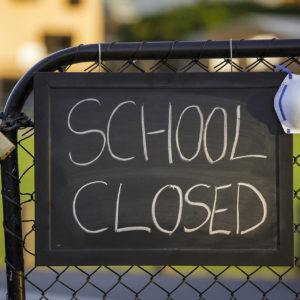The New Hampshire National Education Association has a simple message for the state’s school districts and the Sununu administration about returning to classroom instruction in the fall: It’s our way or the internet superhighway.
On Wednesday, the NEA-NH released its Principles for Reopening, which it says “serve as a set of minimum requirements to be met when negotiating any return to in-person instruction. District plans that include any amount of in-person instruction need to follow these steps before beginning such instruction or allowing staff and students into a school building.”
“If, after working together with the district, it is determined these requirements will not be met, students and staff must return to remote instruction until their school can be made safe,” said NEA-NH President Megan Tuttle.
Polls consistently show that while parents are conflicted over how to balance their fear of COVID-19 with the adverse effects of keeping their kids out of class, a majority say they’re ready for their children to return to the classroom.
The NEA-NH, however, has other priorities. They flatly reject returning to classroom instruction, either full or part time, when schools reopen in the fall.
“NEA-NH believes that remote instruction is necessary during the COVID-19 crisis as a temporary response that protects the health and safety of our students, members and their families,” their statement reads, adding that remote instruction should be used “while the first steps outlined in this document are implemented.”
Among those mandatory steps are “additional money and staff: smaller classes, more bus capacity to enable physical distancing, more nurses and counselors and Education Support Professionals to address student needs,” as well as a guarantee that the state will pay back local schools for “all necessary PPE, physical materials, and other resources necessary for safe reopening in a timely manner.”
The union is also demanding that all students, even the youngest, must wear masks and practice social distancing “in classrooms and in all other group settings.”
Parents who are counting on local schools reopening classrooms so they can return to work now face a new obstacle: teachers unions. While they call for school districts to create committees to “immediately provide opportunities for regular communication about planning for reopening,” the union also pointedly reminded the schools:
“These committees do not supplant the requirements of RSA 273-A to bargain with the union.”
For his part, Gov. Sununu has acknowledged that parents are struggling to decide what the best decision is.
“There’s a lot of anxiety around it. Parents are right to have that anxiety,” Sununu said at Tuesday’s COVID-19 presser. “I guess the confidence there is that the documents and the guidance are in place. The districts are doing right. We have the tools and the resources to make sure that kids can go back in a very healthy and safe way.”
The Sununu administration has committed itself to flexibility, setting aside more than $37 million in CARES Act funds for schools and letting local districts decide the best way to reopen. At the same time, this also forces the local schools to negotiate a deal with the teachers union at a local level as well. And if their public statements are any indication, they aren’t in the mood to cut any deals.
“The 56-pages of reopening guidelines adopted by the Governor can be summed up in five words to our school children and educators: ‘You are on your own,’” the NH-NEA said in a statement.
“They [Gov. Sununu and Commissioner Edelblut] are asking everyone returning to a school building this fall to take part in an experiment to see how many COVID-19 safety standards can be ‘flexed’ at our schools before we get sick enough to close them again,” Tuttle added. “Let me be very clear — we refuse to participate in that experiment.”
For parents, particularly working-class parents with limited incomes and few options, what happens in New Hampshire classrooms is more than just an “experiment.”

